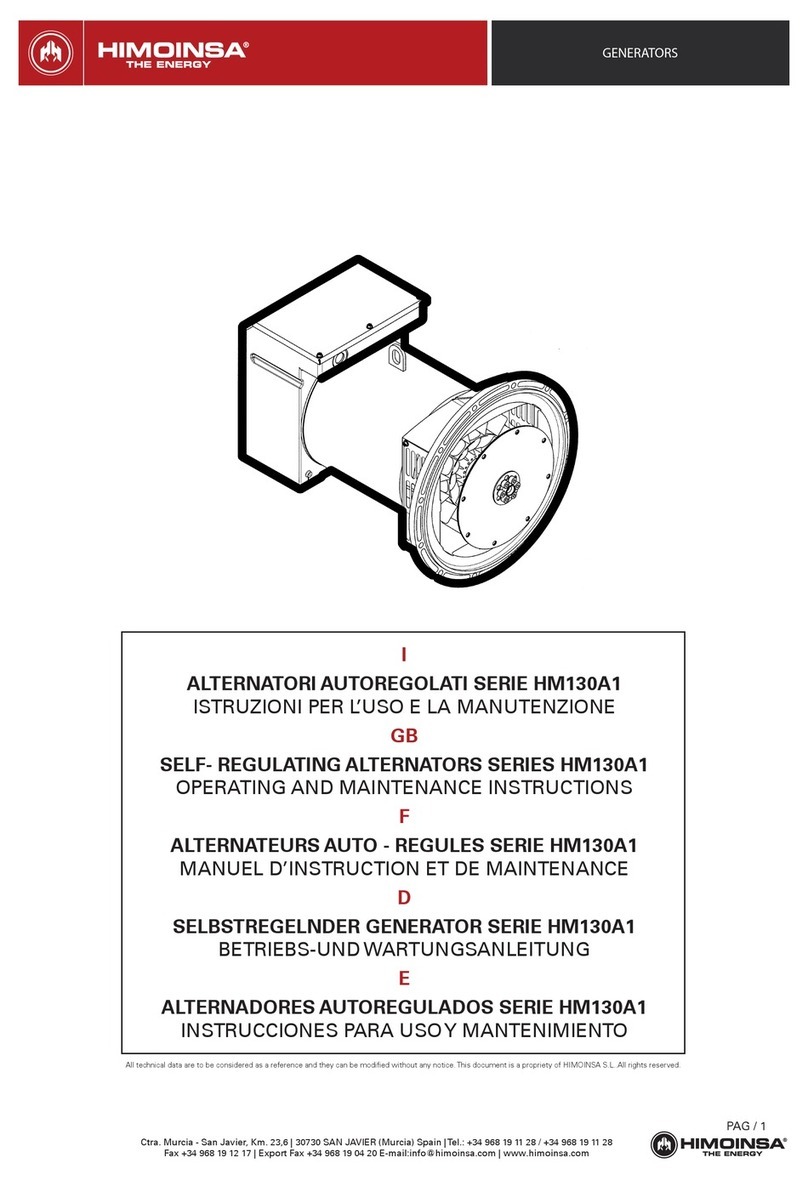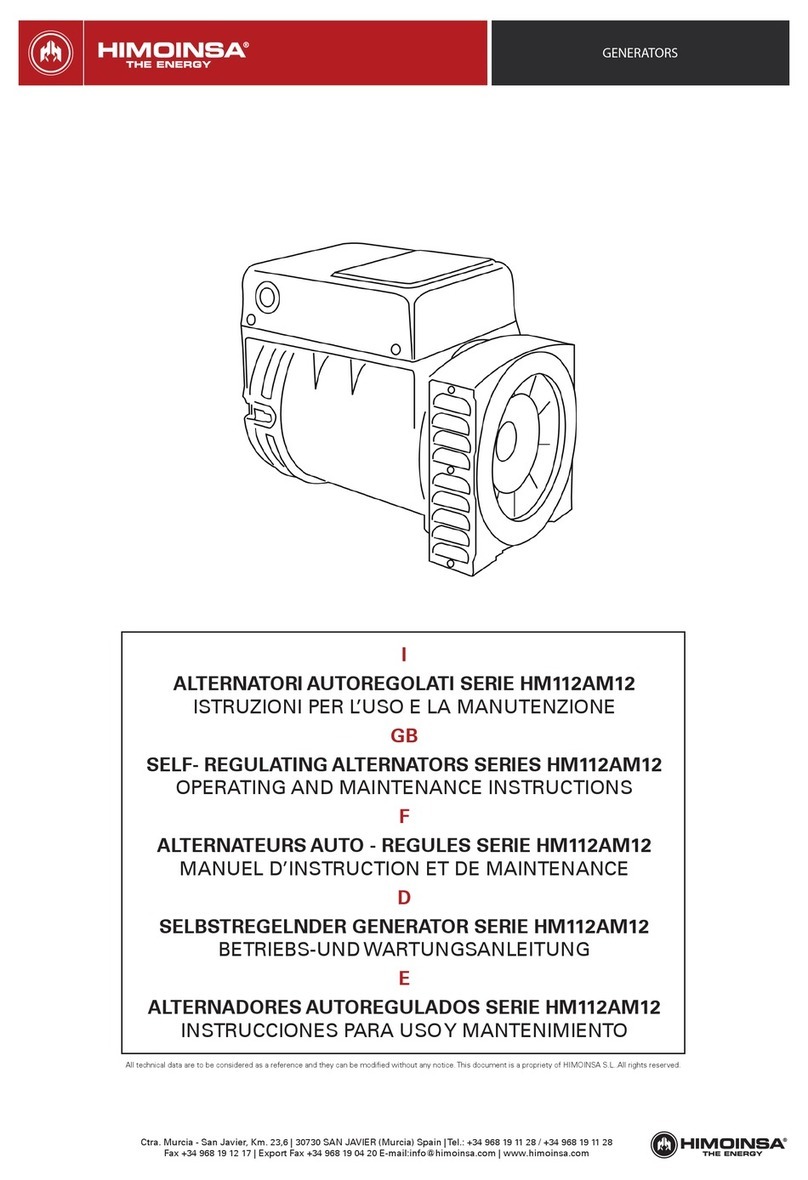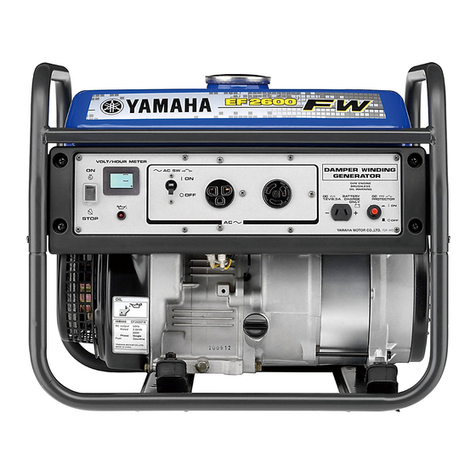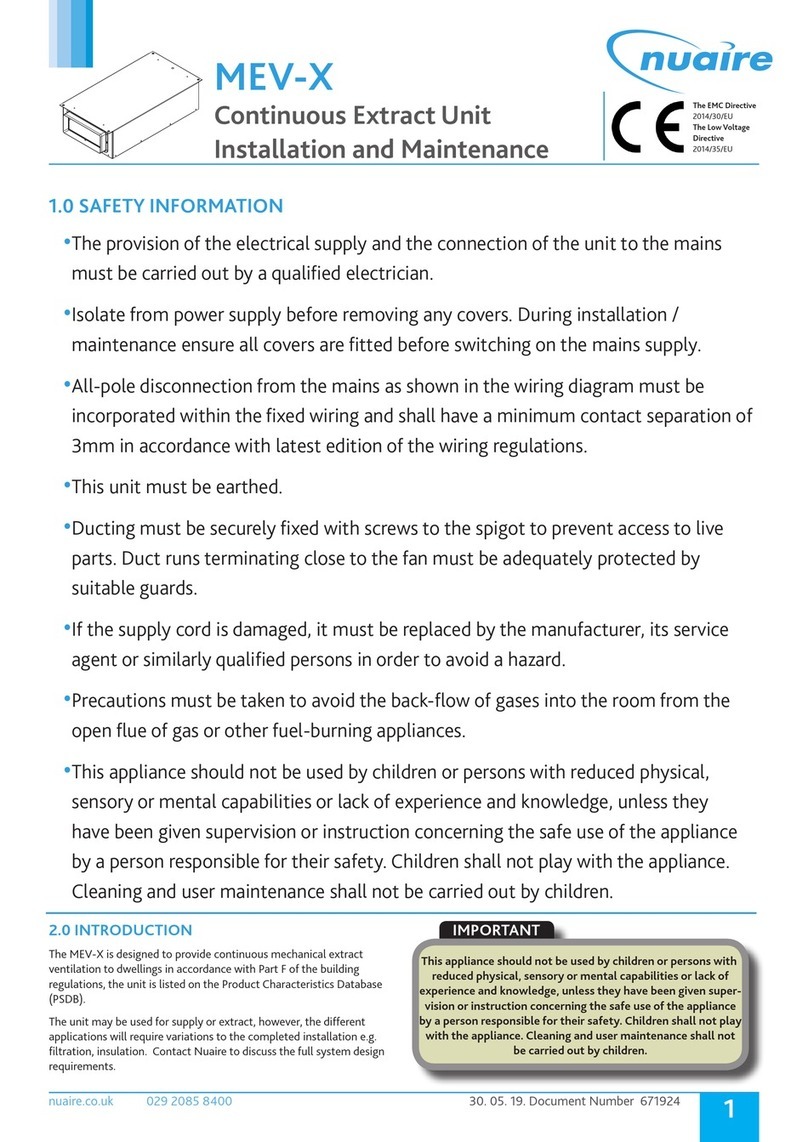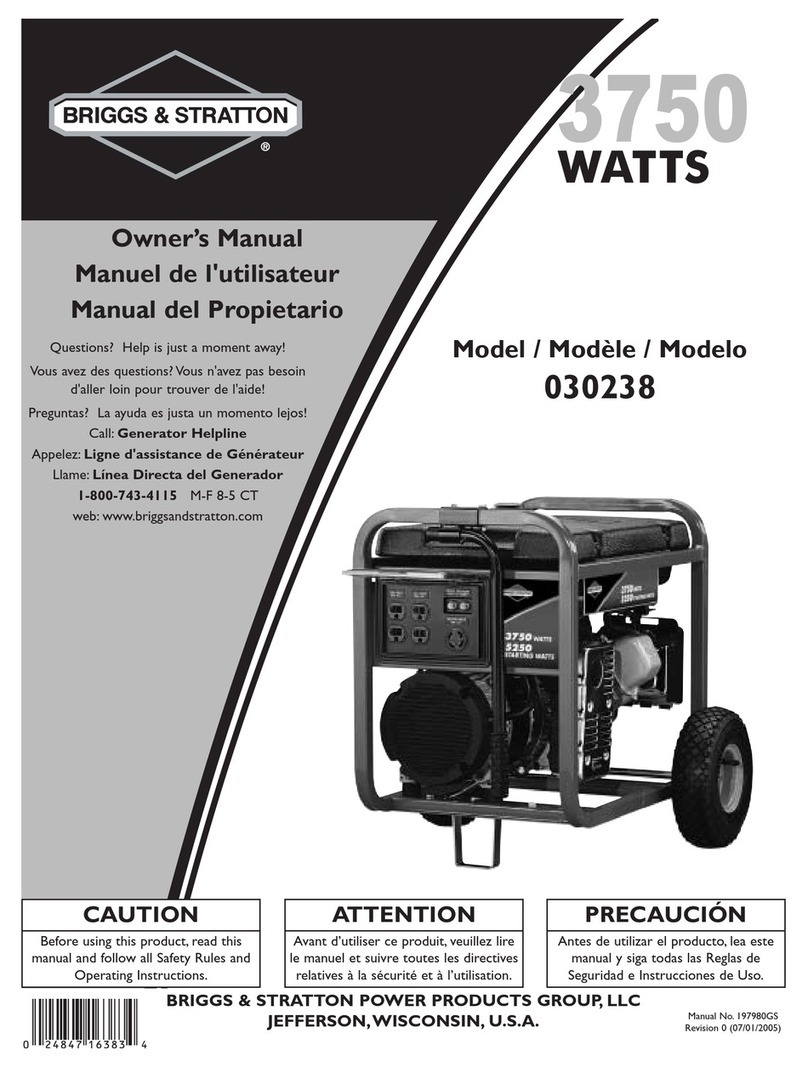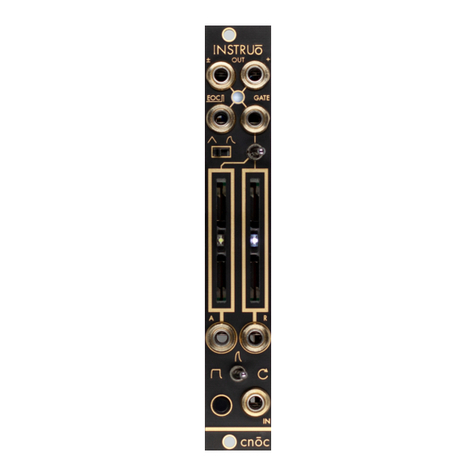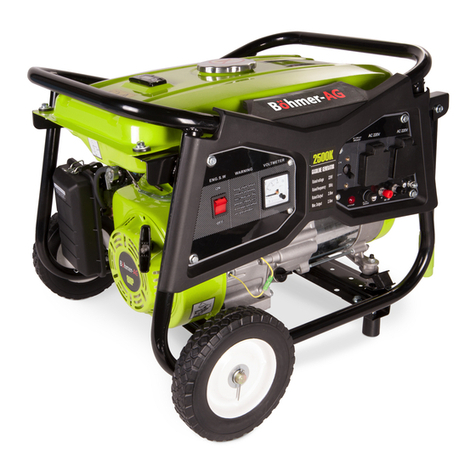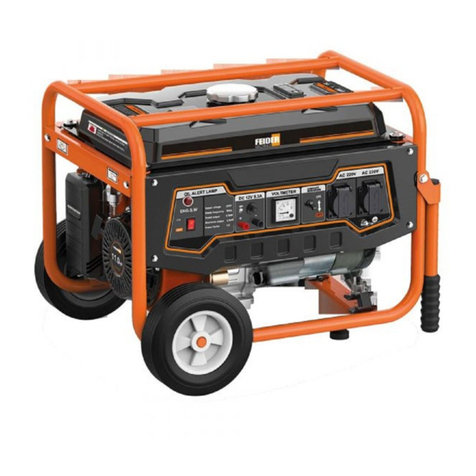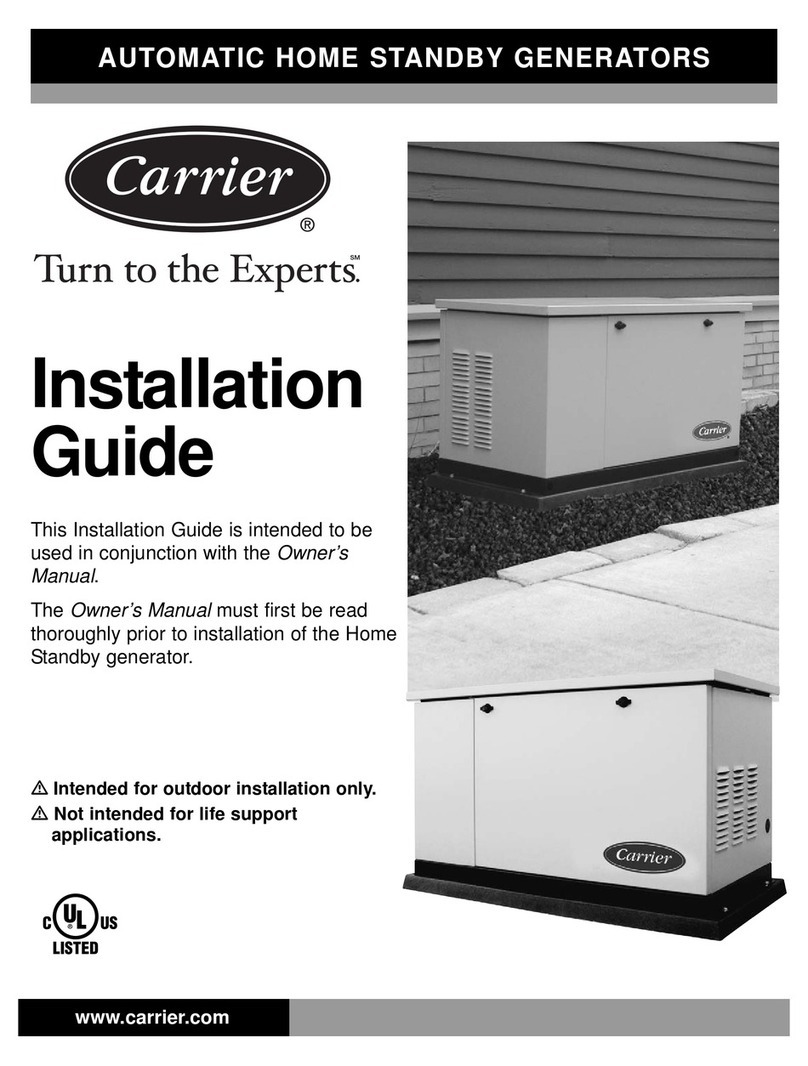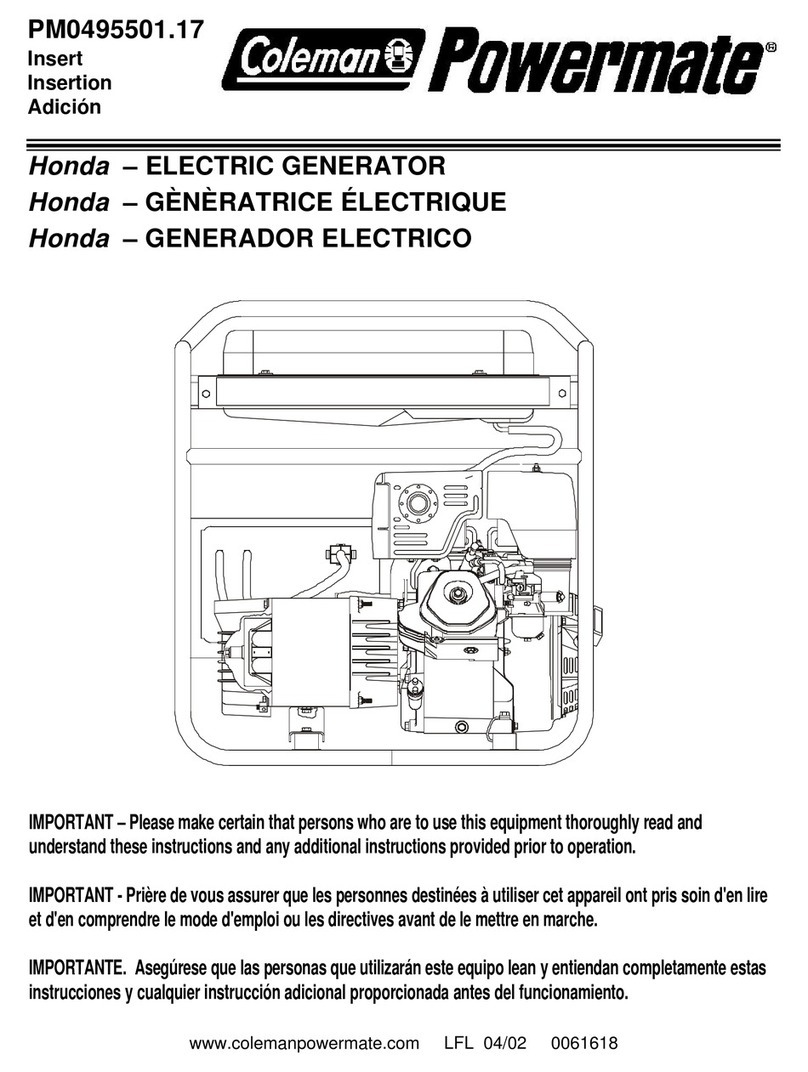Himoinsa STANDARD Operating instructions

OPERATING AND MAINTENANCE
MANUAL
LIGHTING TOWER | COMPACT SERIES
STANDARD
HEAVY DUTY
ECO

| PAGE 2
CONTENTS
3 1. Introduction
4 2. Safety regulations
8 3. Generic description
12 4. Commissioning
17 5. Operations to be performed once the activity has been completed
19 6. Maintenance
21 7. Trouble shooting
21 8. Hydraulic diagram
22 9. Wiring diagram
45 10. Warranty conditions

INTRODUCTION | PAGE 3
1. INTRODUCTION
Through this manual, we intend to provide information and basic instructions for
a correct installation and use of your lighting tower. It is essential that you read
all the safety rules and warnings before, during and after the commissioning of
your lighting tower. Only in this way can we ensure an optimal service under
totally reliable and secure conditions.
HIMOINSA, S.L. considers that it should note in all honesty that the information
described in this manual is valid on the date on which such information is issued,
given that aspects such as technological advances and updates of current
regulations oblige us to make modications without prior notice.
This manual and other documents of reference are part of the lighting tower that
you have acquired and should be preserved and protected against any agent that
can damage them during the life cycle of the tower. This documentation must
accompany the equipment when it is transferred to another user or to a new
owner.
You must always keep the manual close for reference in case of doubt. Although
the information given in this manual has been veried to the detail, HIMOINSA
refuses any responsibility arising from any handwriting errors, typographical, or
transcription.
In accordance with European Directives concerning the Protection of Consumers
and Users, HIMOINSA is excluded from any liability resulting from the defective
installation and/or the improper use of the machine or from failure to comply
with the rules contained in this manual.

SAFETY REGULATIONS | PAG. 4
2. SAFETY REGULATIONS
Before using this equipment read carefully the indicated safety regulations and
nd out about the local safety requirements.
The installation, operation, maintenance and repairs shall be carried out only by
authorized and competent staff.
The owner is responsible for the maintenance of the lighting tower in conditions
of security. Parts and accessories must be replaced if they are not in operating
conditions.
As a premise to the content of this manual, you will nd a detailed description of
the basic criteria that you for your own and that of third parties security, must pay
a close attention.
2.1 GENERAL SAFETY PRECAUTIONS
•It is necessary before any use, to know how to stop the equipment
quickly in case of emergency, and fully understand the operation and
all the controls of your lighting tower.
•Carry out all the relevant checks of the gens-set and the tower, before
putting them into operation, in order to avoid possible accidents, both
personal and to the equipment itself.
•Never allow other people to use the lighting tower unless you have
previously given them the necessary instructions for its proper and
safe use.
•Do not allow its use to minors without the supervision of and adult
who is familiar with the use of the lighting tower.
•Avoid the access of children or pets to the operation area of the
lighting tower, to prevent, to the extent possible, that they may be
injured with any component of the equipment.
•Stop and disconnect the gen-set immediately, as soon as there is any
abnormal situation during operation. Identify and correct the problem
before starting it again.
•Make sure the correct location of the lighting tower on a surface
completely level and stable to ensure a proper operation and get a
perfect stability against the untimely action of the wind.

SAFETY REGULATIONS | PAG. 5
2.3 SAFETY AGAINST THE DANGER OF FIRE
•Always refuel the tank of the gen-set, in a ventilated area with the
engine completely switched off.
•Do not ll the fuel tank of the gen-set when it is running or with the
engine hot.
•Fill the fuel tank to a maximum 90% of its total capacity. Make sure
that the cap of the tank is perfectly closed.
•Check that no fuel has been spilt on the gen-set. If this happens, you
must clean it and let it dry well, before starting the equipment. The
leftover fuel could ignite.
•Diesel is ammable and its vapours explosive. It is forbidden to
spoke, use a naked ame or produce sparks while refuelling or using
the equipment.
•Do not place ammable objects or materials close to the engine
while running and refuel.
•Do not place anything on the air inlet /outlet area and on the exhaust
outlet as this could cause the overheating of the engine and may
create a re hazard.
•Do not place anything on the spotlight immediately after use,
because they come to reach very high temperatures.
2.4 SAFETY AGAINST BURNS
•Never touch the engine or the gen-set exhaust while is running or
some minutes after its stop, it can cause severe burns. Before
handling and maintenance service, let the engine cools down.
•Never touch the halogen lamps during 20-25minutes after its use,
can cause severe burns.
2.5 SAFETY IN THE TOWING
Towing a lighting tower requires care. Both trailer and vehicle must be in good
conditions, and securely fastened to reduce the possibility of accidents. Some
countries, requires the trailer be registered and licensed. Contact the Trafc
•Lower the mast if strong winds (more than 80km/h) or thunderstorms
are expected in the area.
•The tower extends up to 9m. Make sure area above it is open and
clear of overhead wires and obstructions.
•If for any reason any part of the mast hangs up or the winch cable
develops slack while raising or lowering the tower, STOP immediately
and contact with the Technical Department at HIMOINSA.
•Make sure that chains, hooks, ramps, jacks and any other type of
lifting devices are attached securely and have enough counterweight
to lift and hold the equipment safely. Remain aware of the position of
other people around you when lifting the mast.
•NEVER remove the safety lock or pull the locking pin while the mast
is up.
•NEVER adjust the mast when the unit is in operation.
•NEVER turn on the lights without the protection glass cover placed or
with a cracked or damaged glass.
IMPORTANT
Always put the support skids for achieving a secure and perfect stability of the
lighting tower with the help of the spirit level.
2.2 SAFETY AGAINST THE DANGER OF ELECTROCUTION
•Never handle the lighting tower and its gen-set with wet hands of feet.
If the tower is stored outside, check that the engine and alternator
are dry. Dry them if they are wet.
•Never touch bare wires or disconnections. Keep electrical wires and
connections in good condition.
•Always use the suitable plugs for the outlet bases provided on
the generator set. Never use zinc or cables without a plug or with
stripped ends. Introducing these cables directly into the outlet socket
could create a high risk of electrocution.
•As soon as you notice any cable in a poor condition, replace it and
make sure it is in perfect condition before switching on the lighting
tower again.

SAFETY REGULATIONS | PAG. 6
Picture Location Information
Located on the connections
from the alternator to the
engine. Whenever there are
timing belts or transmission
shafts.
They warn of the danger in case an alien
object collides with the timing belts or
with the components in motion that they
connect.
Located on the parts of the
genset that heat up during
operation.
They indicate those areas which must not
be touched while the set is in operation or
shortly after having stopped.
Placed on the coolant tank
cap.
They warn of the precautionary measures
to be taken when opening this cap. The
liquid is hot and may spout and cause
scald.
Located on the bonnet and
next to the lifting eye.
It indicates the point by which the set
must be lifted in order to move it.
Located next to the fuel cap.
Depending on the model, it can
be either on the bedplate or
next to the engine.
Indicates the location of the fuel tank and
the ller cap.
Located on both sides of the
bedplate skids.
It indicates the advisable area to move
the set by means of a forklift truck.
Located next to the oil ll
dipstick and oil ll cap.
Indicates the location of the oil ll
dipstick.
Next to the derivations of the
grounding protections.
They are the parts by means of which
the genset is protected against possible
electric shocks.
Next to the protective ther-
mal-magnetic switches of the
genset.
They protect the genset against possible
overcurrent that may occur during charge.
On the emergency stop.
It indicates the location of the emergency
stop button which allows the simultane-
ous stop of the genset.
Agency of your country to check the necessary licenses for your particular unit.
•Check that the hitch and coupling on the towing vehicle are rated
equal to, or greater than the trailer’s “gross vehicle weight rating”
(GVWR).
•Check the state of the tire on trailer, ination and tread wear.
•Check the hitch and coupling for wear or damage. DO NOT tow the
lighting tower using defective parts. Make sure that the hitch and
coupling are compatible. Make sure that the coupling is securely
fastened to the vehicle.
•Check that directional and brake light on the trailer are well
connected and working properly.
•The maximum recommended speed for road towing is80km/h.
Recommended off-road towing speed is not to exceed15km/h
depending on terrain.
•Always maintain an extra safety space between vehicles and avoid
verges, curbs and sudden lane changes. If you have not pulling
atrailer before, practice turns, stops and the reverse in a trafc-free
area.
•A lm of grease on the coupling will extend its life. Wipe the coupler
and apply fresh grease each time the trailer is towed.
•ALWAYS lower the mast before removing the hand brake.
•Before moving the tower, make sure ALWAYS that the mast is fully
folded and with the safety lock.
•Make sure that the spotlights are folded and locked in the transport
position.
•Make sure that the stabilizers are fully gathered and fastened.
IMPORTANT
NEVER move the lighting tower with the mast unfolded.
2.6 SAFETY STICKERS AND INFORMATION
There are some safety stickers and information all over the gen-set. Following
you can nd a brief explanation of their location and information on each of them.

SAFETY REGULATIONS | PAG. 7
Picture Location Information
Located on the control panel. They warn of electric shock hazard.
Always located on the ther-
mal-magnetic switch.
They indicate the prohibition of manipulat-
ing the genset when the switch is on.

GENERIC DESCRIPTION | PAG. 8
3. GENERIC DESCRIPTION
3.1 COMPONENTS OF THE LIGHTING TOWER
HIMOINSA lighting towers have been made with top quality materials, and with
the effort of our technical and production team, without sparing resources to
achieve high-performance and versatile operation lighting towers. They are
composed of a tower kit and a gen-set, all in a compact and well-balanced trailer.
1. The lighting tower kit is composed of:
•Manual lift mast and 9 expansions, to reach a total working height of
9metres with a 360º manual rotation of the light beam.
•Support for 4floodlights (IP65) with1000w metal halide lamps
and 100,000lumens each (standard for COMPACT STANDARD and
COMPACT HEAVY DUTY models). Lamps prepared to work in ambient
temperatures of -20to45ºC.
•As an optional support for 4 LED 350W floodlights and with 47,955
lumens each (Standard for COMPACT ECO). Lamps prepared to work
in ambient temperatures of -20 to 45ºC.
2. To highlight in between the other components of the lighting tower:
•Soundproofed generator set driven by a YANMAR diesel engine of
high reliability, for model 3TNV76 - GGEH (STANDARD and HEAVY
DUTY) and model L100N5 (50Hz) L100N6 (60Hz) (ECO), cooled by
water and with a very low fuel consumption.
•Sealed control panel for protection and manoeuver. The control
panel incorporates the M7 controller, circuit breakers for the
protection of the spotlights and auxiliary sockets.
•2auxiliary power outlets. The tower has two auxiliary sockets of
16amps, for the supply of power to auxiliary equipment.
•Double safety lock in mast. Ensures the blockage of the mast and
prevents involuntary turns during the transport. It is necessary to
unlock it for the rotation and orientation of the oodlight.
•Emergency stop.
•Wide access for maintenance and control.

GENERIC DESCRIPTION | PAG. 9
•4levelling jacks, two of them extensible to ensure the perfect
stability of the tower in any working surface. It cancels the risk of
overturn in adverse environmental conditions.
•Spirit level, located in the upper part of the set, to ensure a perfect
levelling of the tower.
•Exhaust outlet.
•Light Sensor, located on the bonnet of the generator set (OPTIONAL).
•Inclination of lights, using a servo motor, with possibility of turning by
up to 30ºC (OPTIONAL).
3. Mobile equipment:
•Transportation kit, the tower is ready for road transport. Including
as standard: jockey wheel, straight drawbar with ball coupling and
connections for signalling lights (brake lights, indicators), as well as
position and handbrake reectors. As optional we have swan neck
and adjustable drawbars available, as well as the ring type hitches
(See Fig. 1, 2 and 3).
•Includes forklift pockets to move it with a forklift.
•Fixing rings for the transport that ensure a perfect immobilization
avoiding possible damage during the transport.
Fig. 1
Swan neck type drawbar
Fig.2
Adjustable type drawbar
Fig.3
Ring type hitch
3.2 TECHNICAL DATA STANDARD HEAVY DUTY ECO
50 Hz 60 Hz 50 Hz 60 Hz 50 Hz 60 Hz
LIGHTING TOWER
Tower Model
APOLO
COMPACT
STD M5
APOLO
COMPACT
STD M6
APOLO
COMPACT
HD M5
APOLO
COMPACT
HD M6
APOLO
COMPACT
ECO M5
APOLO
COMPACT
ECO M6
Power (P.R.P.) kVA 6,4 7,2 6,4 7,2 4,5 5,2
Voltage (3P + N + T) V 230 240 230 240 230 240
Maximum dimensions -
mm. (in working position) (LxWxH) 2,425 x 2,634 x 9,219 2,457 x 2,645 x 9,298 2,425 x 2,634 x 9,219
Minimum dimensions -
mm. (in transport mode) (LxWxH) 2,425x1,340x2,033 2,457x1,340x2,155 2,425x1,340x2,033
Weight Kg 911 911 749
Type of fuel Diesel Diesel Diesel
Tank capacity L 100 100 100
Filling of the tank External External External
Running time Hr 63 54 63 54 166
Noise level (power - at
7m)
90LWA-
65dB(A)
92LWA-
67dB(A)
90LWA-
65dB(A)
92LWA-
67dB(A)
90LWA-
65dB(A)
92LWA-
67dB(A)
ENGINE
Model
YANMAR
- 3TNV76 -
GGEH
YANMAR
- 3TNV76 -
GGEH
YANMAR
- 3TNV76 -
GGEH
YANMAR
- 3TNV76 -
GGEH
YANMAR -
L100N6
YANMAR -
L100N6
Cylinders 3L 3L 1
Aspiration Natural Natural Natural
Operating regime r.p.m. 1500 1,800 1500 1,800 3.000 3.600
Cooling system Liquid Coolant Liquid Coolant Air
Fuel consumption (only
the lights) L/Hr 1,59 1,84 1,59 1,84 0,4 - 0,7
Governor Mechanical Mechanical Mechanical
ALTERNATOR
Poles Nº 4 4 2
Type Brushless Brushless Brushless
Voltage governor AVR (electronic) AVR (electronic) AVR (electronic)
Insulation Class H Class H Class H
Bearings 1 1 1
Coupling SAE5-7.5” SAE5-7.5” SAE J609a B/6
MAST
Mast type Hydraulic Hydraulic Hydraulic
Mast sections 9 9 9
Rotation 360º manual 360º manual 360º manual
Double safety block Standard Standard Standard
Spotlights Nº 4 x 1000 W 4 x 1000 W 4 x 350W
Type of spotlights Metal Halide Metal Halide LED
Total lumens lm 4 x 100,000 = 400,000 4 x 100,000 = 400,000 4 x 47,955=191,820
Light eld 33,000 m233,000 m216,000m2
Remaining power 2.3kW 3.2kW 2.3kW 3.2kW 3.06kW 3.76kW

GENERIC DESCRIPTION | PAG. 10
STANDARD HEAVY DUTY ECO
50 Hz 60 Hz 50 Hz 60 Hz 50 Hz 60 Hz
CANOPY
Soundproof hood Standard Standard Standard
Auxiliary power outlets 2 x 16 Amp. 2 x 16 Amp. 2 x 16 Amp.
Auxiliary supply input 1 x 32 Amp. 1 x 32 Amp. 1 x 32 Amp.
Lifting hook Standard Standard Standard
CHASSIS
Chassis traction kit Standard Standard Standard
Stabilisers 4 4 4
Signalling lights Standard Standard Standard
Wheels 2 x 165R13 2 x 165R13 2 x 165R13
A fork carriage Standard Standard Standard
CONTROL PANEL
Control and protection
unit M7 manual control unit M7 manual control unit M7 manual control unit
Thermal-magnetic circuit
breaker to protect the
spotlights and the auxilia-
ry outlets
Standard Standard Standard
Manoeuvring pushbuttons 2 (1 up, 1 down) 2 (1 up, 1 down) 2 (1 up, 1 down)
2425 mm (Standard and Eco)
2457 mm (Heavy Duty)
2033 mm (Standard and Eco)
2155 mm (Heavy Duty)
1340 mm MIN / 2634 mm MAX
(Standard and Eco)
1340 mm MIN / 2654 mm MAX (Heavy Duty)
2033 mm MIN / 9219 mm MAX (Standard y Eco)
2155 mm MIN / 9298 mm MAX (Heavy Duty)

GENERIC DESCRIPTION | PAG. 11
Fig. 6
Apolo Heavy Duty
Fig. 5
Apolo Eco
3.3 PACKING PLAN
9 units per trailer
13.5 mt
UNIDADES POR
CONTENEDOR
9 units per container4 units per container
20’ 40’
Fig. 4
Apolo Compact Standard

COMMISSIONING | PAGE 12
4. COMMISSIONING
Before starting the lighting tower check its correct location on a rm and totally
levelled ground, to ensure a proper operation and stability in case of a strong
wind.
NOTE
Do not raise the mast if strong winds (more than 80km/h) or thunderstorms are expected
in the area.
4.1 CHECK LEVELS OF THE EQUIPMENT
Check engine oil, fuel and coolant levels as well as air lter condition (ref. engine
manual).
Check the hydraulic oil level of the tower (Ref. 6 Maintenance).
4.2 ANCHORAGE
Once carried out these important and simple checks to ensure the proper
operation of the tower and the gen-set, we will proceed to the correct anchorage
of the APOLO COMPACT lighting tower. You must follow the following steps
accurately:
•Turn the handle clockwise to raise the trailer hitch on the tow vehicle.
•Pull up the locking pin (A) and extend the outriggers (B) until the spring
pin snaps back into place.
A
B
Fig. 1

COMMISSIONING | PAGE 13
Fig. 4 Fig. 5
4.3 ADJUSTMENT OF THE SPOTLIGHTS
Before raising the tower it may be necessary to adjust the lamps.
The spotlights are already installed in the tower and can be oriented easily
thanks to small levers that allow easy mobility through 180º.
Fig. 6
•Turn the jack handle clockwise to start levelling the trailer until it is in
rm contact with the ground and the trailer is as level as possible.
Fig. 2
•Only the legs are removed from the front, the rear legs are xed and
are easily adjusted with the corresponding pins.
Fig. 3
•Once the 4 support legs have been adjusted and the tower is level
with the help of the sprit level, lower the jockey wheel until it rests on
the working surface.

COMMISSIONING | PAGE 14
PULL
LOCK
PULL
RELEASE
Fig. 8
•Proceed to raise the mast by pressing the up button located on the
control panel.
Fig. 9
•The mast has a lock which xes the orientation of the spotlights.
Whenever you want to change the orientation you must remove the
lock by moving the lever to the RELEASE position, turning the mast to
the desired position and then xing the mast with the lever, putting it
into the LOCK position.
PULL
LOCK
PULL
RELEASE
Fig. 10
4.4 RAISING THE TOWER
The trailer must be levelled with the outriggers extended before raising the tower
mast and must remain extended while the tower is up. Failure to level the trailer or
extend the outriggers will severely reduce the stability of the unit and could allow
the tower to tip and fall.
Do not start the unit if the insulation on the electrical cord is cut or worn through.
Bare wires in contact with the mast or frame may energize the trailer and cause
electrocution. Repair or replace cord immediately.
IMPORTANT
In order to proceed with the raising of the mast it is essential to rst apply the
handbrake. If the handbrake is not engaged, for safety reasons, the mast will not
rise.
Fig. 7
•Check the mast cables for excessive wear and tear or damage. Check
the electrical cord for damage.
•Make sure the area behind the unit is clear before raising the mast to
the vertical position.
•Make sure the mast is in the locked position.

COMMISSIONING | PAGE 15
4.5 GENSET STARTING
VERY IMPORTANT
Never start the gen-set with load, that is, check that all the circuit breakers are
switched off.
Before starting the engine:
•Check the fuel level.
•Check the oil level.
•Check the coolant level.
•Make sure that the main circuit breaker is OFF.
CUADRO MANUAL PARA TORRE DE ILUMINACION
ESQUEMA ELÉCTRICO DE CONTROL "M7"
Y PROTECCIÓN MAGNETOTÉRMICA
LIGHTING TOWER MANUAL START CONTROL PANEL
"M7" CONTROL AND THERMAL MAGNETIC
PROTECTION ELECTRIC DIAGRAM
DE 10 AMPERIOS
FROM 10 AMPERES
*WARNING*
MAKE SURE ALL THE POWER UNITS ARE OFF
BEFORE START THE GENSET!!
www.himoinsa.com
1 2 3 54 76 8 9 10 1211 1413 15 16
Telf. 968 191 128
APPROVED:
OLD CODE:
NEW CODE:
DESIGN:
REVISED/
NAME:
DATE: SIGNATURE DESCRIPATION:
Nº P.:
REVISION:
SCALE:
CODE:
CTRA.MURCIA-SAN JAVIER KM 23.600 C.P. 30730 - MUR CIA - ESPAÑA
1/17/2014
1/17/2014
mm
03
Miguel Utrillas
CCAC16AB20002-R0
Fig.12
Once the above has been veried you can now start the gen-set.
(A) Manual start
(B) Free voltage contact start
A B
Fig.13
•To return the spotlights to their original position, you must set the
lever to the RELEASE position, turn the mast to the original position
and secure it again (LOCK).
•For safety reasons, once the work is nished, it is always recommend-
ed that the mast is kept in the original locking position that was given
at the factory, thus avoiding damage to the machine.
PULL
LOCK
PULL
RELEASE
Fig.11
IMPORTANT
Whenever the brake is deactivated, the mast, for security reasons, will descend
automatically.

COMMISSIONING | PAGE 16
4.6 SWITCHING ON THE SPOTLIGHTS
Finally, it will only be necessary to operate the switches located on the control
panel
CUADRO MANUAL PARA TORRE DE ILUMINACION
ESQUEMA ELÉCTRICO DE CONTROL "M7"
Y PROTECCIÓN MAGNETOTÉRMICA
LIGHTING TOWER MANUAL START CONTROL PANEL
"M7" CONTROL AND THERMAL MAGNETIC
PROTECTION ELECTRIC DIAGRAM
DE 10 AMPERIOS
FROM 10 AMPERES
*WARNING*
MAKE SURE ALL THE POWER UNITS ARE OFF
BEFORE START THE GENSET!!
www.himoinsa.com
1 2 3 54 76 8 9 10 1211 1413 15 16
Telf. 968 191 128
APPROVED:
OLD CODE:
NEW CODE:
DESIGN:
REVISED/
NAME:
DATE: SIGNATURE DESCRIPATION:
Nº P.:
REVISION:
SCALE:
CODE:
CTRA.MURCIA-SAN JAVIER KM 23.600 C.P. 30730 - MURCIA - ESPAÑA
1/17/2014
1/17/2014
mm
03
Miguel Utrillas
CCAC16AB20002-R0
Fig.14
VERY IMPORTANT
The spotlights must be always switched off when raising/lowing or aiming.

OPERATIONS TO BE PERFORMED ONCE THE ACTIVITY HAS BEEN COMPLETED | PAGE 17
5. OPERATIONS TO BE PERFORMED ONCE THE
ACTIVITY HAS BEEN COMPLETED
5.1 SWITCHING OFF THE SPOTLIGHTS
Switch off the spotlights switches and stop the gen-set (see control unit manual).
CUADRO MANUAL PARA TORRE DE ILUMINACION
ESQUEMA ELÉCTRICO DE CONTROL "M7"
Y PROTECCIÓN MAGNETOTÉRMICA
LIGHTING TOWER MANUAL START CONTROL PANEL
"M7" CONTROL AND THERMAL MAGNETIC
PROTECTION ELECTRIC DIAGRAM
DE 10 AMPERIOS
FROM 10 AMPERES
*WARNING*
MAKE SURE ALL THE POWER UNITS ARE OFF
BEFORE START THE GENSET!!
www.himoinsa.com
1 2 3 54 76 8 9 10 1211 1413 15 16
Telf. 968 191 128
APPROVED:
OLD CODE:
NEW CODE:
DESIGN:
REVISED/
NAME:
DATE: SIGNATURE DESCRIPATION:
Nº P.:
REVISION:
SCALE:
CODE:
CTRA.MURCIA-SAN JAVIER KM 23.600 C.P. 30730 - MURCIA - ESPAÑA
1/17/2014
1/17/2014
mm
03
Miguel Utrillas
CCAC16AB20002-R0
Fig.1
5.2 LOWERING THE MAST
We advise you to wait between 20-25 minutes before lowering the tower. Due to the
high temperatures that the laments of the spotlights reach, they are very vulnerable
to the slight vibrations that inevitably occur when the mast is being lowered.
•Press the down button installed on the control panel
Fig.2

OPERATIONS TO BE PERFORMED ONCE THE ACTIVITY HAS BEEN COMPLETED | PAGE 18
5.4 ROAD TRAVEL
Wind the jockey wheel up for road travel.
NOTE
Make sure when raising the jockey wheel that ts perfectly, this will avoid turns
during the transport which could cause damage to the machine. Fig. 7 & 8.
Place the hitch ball positioned with the towing vehicle.
ATTENTION!
Fig. 7 Fig. 8
Place the hitch ball positioned with the vehicle.
When you see a green mark on the safety button the anchoring will be perfect.
Fig. 9
5.3 RETRACT TELESCOPIC LEGS
IMPORTANT
To proceed with the retraction of the telescopic legs make sure that the jockey
wheel is lowered and xed to the surface. Fig. 3 & 4.
Fig. 3 Fig. 4
Then raise, retract and stow the legs in travel position, with the locking pins
facing upwards. Fig. 5 & 6.
Fig. 5 Fig. 6

MAINTENANCE | PAGE 19
6. MAINTENANCE
6.1 GENSET MAINTENANCE
General maintenance (refer to the gen-set manual)
6.2 LIGHTING TOWER
One might well say that thanks to the simple nature of the system and to the
quality of the materials used during the manufacturing process, the tower itself
does not actually require exhaustive maintenance.
Be that as it may, we should perform the following operations:
1. Regular cleaning of the machine is recommended in order to prevent any
deposits of dirt that could compromise its efciency. The frequency of this
operation depends on its place of use.
2. To lubricate the pulleys use the grease recommended for low temperature and
very high speed applications. It is recommended to use SKF LGLT 2 grease, a top
quality lithium soap product with a 100 % synthetic base oil. If using another
lubricant, this must still be characterised by a base oil viscosity of 18 mm²/s
at 40°C and 4.5 mm²/s at 100°C.
3. To grease the telescopic columns, use a WD40 type lubricant spray. Apply the
spray to the metal parts to facilitate the sliding of the various sections during the
operations to raise and lower the tower. In case of frequent use, carry out this
operation every three months.
4. Were a halogen bulb to blow, we recommend you use gloves or a cloth when
replacing it.
5. Do not touch the bulbs directly with your ngers.
6. If the lighting tower is working in a damp, dusty place, it must be cleaned and
dried frequently.
7. To change or check the battery, access through the right side of the lighting
tower.

MAINTENANCE | PAGE 20
Lamp specifications:
•Name: single ended halide
•Base Designation: MOG(E39)
•Bulb Designation: BT37
•Lamp Wattage (W): 1000W
•Operating Voltage (V): 263V
•Operating Current (Amps): 4.1A
10. Hydraulic-oil unit.
•Check the hydraulic-oil unit and hydraulic oil level every 300 hours
or 3 months of work. Fill up with the same oil if necessary, always
eliminating any oil leakage that may exist.
•If the hydraulic cylinder rises unevenly or intermittently, check the
hydraulic oil level.
•Change of hydraulic oil every 2400 hours or 2 years of work or
when it loses its properties or in the case that it is contaminated by
another product.
•Each time the hydraulic oil change is performed, the lter is changed
and the tank cleaned.
•In the event that the electrovalve does not work or another problem
prevents the mast from descending automatically, this operation is
carried out by loosening the electrovalve screw. To lower the mast it is
important that the electro-valve screw is well tightened.
•Perform a revision of the hydraulic-oil unit if hydraulic oil is detected
on the ground.
Fig. 1
8. Steel cables and pulley sets:
•Carry out periodic checks of the cables state, every 100hours or
once a month.
•When the steel cable decreases by 10% of the rated diameter due to
corrosion or abrasion, it must be replaced immediately.
•Check the cables. If a steel cable has broken, replace it as soon as
possible.
•If there is any manner of deformation (a loop, a knot or crushing),
replace the cable immediately.
•Important: always use the Steel cables indicated by the manufacturer
of the lighting tower (type 6x37 +1).
•Lubricate galvanized cables with oil when operating in high corrosion
conditions every 300hours or 3months.
9. Replacing the light bulbs and glasses.
The metal halide bulbs used in the column lights provide more powerful lighting
than ordinary halogen bulbs, for a lower consumption, with a very high service life
of approximately 8,000 hours.
Metal halide bulbs are discharge bulbs that operate using the emission of
electromagnetic rays by an ionized gas plasma. The gas is ionized using an
electric discharge (hence the name) through the gas itself.
Metal halide lamps are derived from high pressure sodium vapour lamps, with
additives (thallium, indium, dysprosium, holmium, caesium, thulium) which
improve the colour rendering of sodium lamps, giving them a very high colour
temperature (4,000-5,600 K). Their chromatic performance makes them
particularly useful when perfectly white light is required. They require special
igniters and injectors to light and these produce pulses of start-up voltage of
between 0.75 and 5 kV. During the lighting phase, it takes several minutes to
reach the maximum light output.
To replace the light bulb or glass, follow the procedure below:
•Unx the screw of the clamp (M5) with a star-shaped screwdriver and
place the clamp and the glass on a safe place.
•Replace the bulb or glass.
•Place the glass on the clamp and then both of these in the body of
the lamp. Check that the clamp has been set in place properly and
tighten the screw.
NOTE
If in doubt, contact our technical service.
Electro-valve screw
Oil ller cap
Oil drain cap
This manual suits for next models
2
Table of contents
Other Himoinsa Portable Generator manuals
Popular Portable Generator manuals by other brands
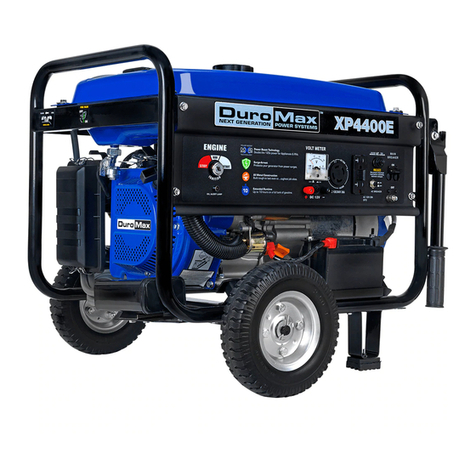
DUROMAX
DUROMAX XP4400E owner's manual
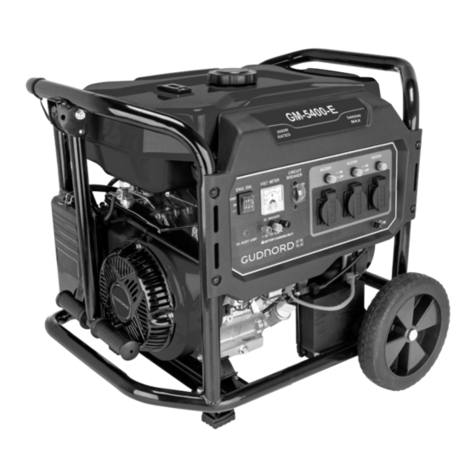
GUDNORD+
GUDNORD+ GM-5400-E Translation of original instruction manual
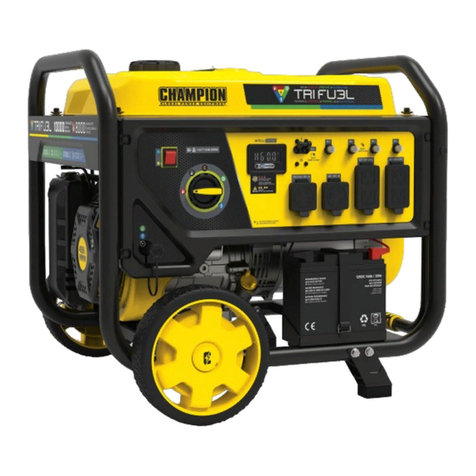
Champion Global Power Equipment
Champion Global Power Equipment 201121 quick start guide
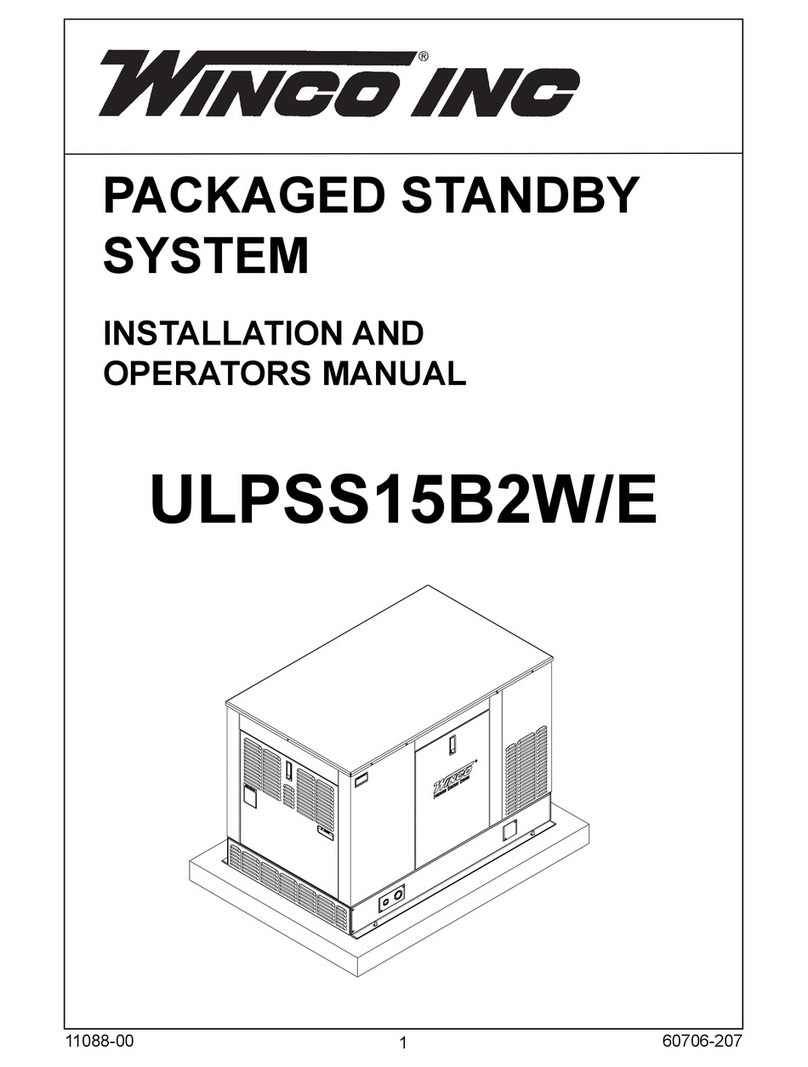
Winco
Winco ULPSS15B2W Installation and operator's manual

Navigator
Navigator NG2500 owner's manual
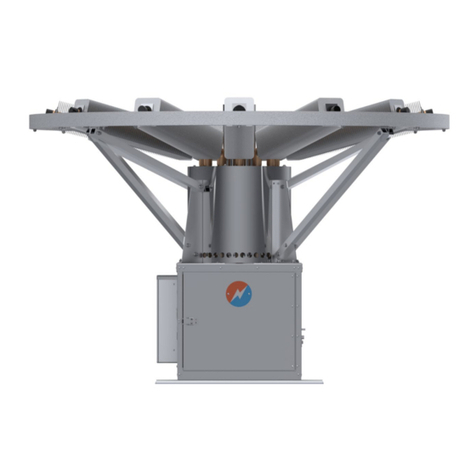
Global
Global 8550-RU operating manual
